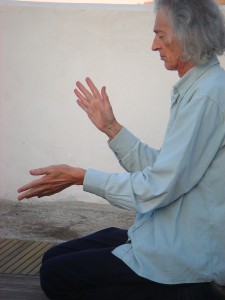GYOKI – A DYNAMIC AWARENESS EXERCISE: BREATHING BODY-MIND
Seiki begins at zero. It is a way of knowing ourselves through inner experience, starting with elementary practical exercises that help us work consciously to harmonise breath, body and mind. It is of interest to professional therapists but it has as much to do with our development as social individuals as with the healing of illness, so it is for everyone without distinction and regardless of achievement.
I would like to describe one of the most basic and fundamental Seiki practices, something that we can all begin simply, and use to develop our sensitivity, spontanaeity and self-understanding. The practice is called Gyoki, that is “cultivating a feeling for Ki”, which is life-movement, or simply the breath. The increased sensitivity is directly beneficial, principally for ourselves, but also in our work with others. Actually it’s a kind of meditation focussed on the subtle flow of movement throughout the body asssociated with breathing. Simply by relaxing and paying attention, we can be aware of the passage of the breath as it enters through the nose and sinus region, as it is drawn into the chest cavity by the movement of the ribs and diaphragm, and thereby creates a wave of pressure that extends down into our belly. It’s a movement that gently changes our posture as we sit or stand, as the spine also accommodates to the inflow and outflow of breath. This happens by itself, but we usually don’t feel it fully. Unconsciously we often curtail or confine the natural flow due to muscular tension, emotional stress and poor postural habits.

In Gassyo Gyoki practice we take a little time out to feel our body-self in the live situation of here and now, just as it is. We bring our awareness to bear on the situation by focussing on our breathing – an old standard among meditation methods – but as we sit or stand quietly, joining the hands or gently separating them during the space of a few minutes, we begin to imagine the breath entering and leaving via the finger-tips or, if we have separated the hands, flowing in and out through the palms as well. Without doing anything else at all, we wait for feeling to guide us. The skin of the hands is remarkably sensitive – so many nervous pathways running directly from hand to brain easily pick up subtle signals.  So it turns out that we do breath though our hands. Our skin is a sense organ, and it both breaths and feels. Its just that we’re not often listening. This useful meditation tool is great for modern people because it is not that formal.
So it turns out that we do breath though our hands. Our skin is a sense organ, and it both breaths and feels. Its just that we’re not often listening. This useful meditation tool is great for modern people because it is not that formal.
It is important to practise in a space as free of clutter as possible, then we can close our eyes to avoid distraction and really let ourselves go with whatever we feel. Sometimes there are surprisingly definate sensations of pressure, pushing the hands apart or pulling them together; magnetic attraction or repulsion; an airy lightness or an increasing heavinessmay be felt. We can allow any changes of position or  movement impulse of whatever type, but there is no need to force anything, so we might find ourselves sitting with certain feelings or sensations but no particular movement, apart from the breath itself of course. That reminds us we are alive at least. We might feel pain or strain, impatient restless surges, moments of delight or tranquil inner calm. Our senses generally becoming more alert, the sounds and smells of the world around just come and go. Strange moods may descend on us. No matter. This is just a step on the interior path that we can explore in our search for health and happiness both for ourselves and others. It is a challenge in this world, just to become more sensitive.
movement impulse of whatever type, but there is no need to force anything, so we might find ourselves sitting with certain feelings or sensations but no particular movement, apart from the breath itself of course. That reminds us we are alive at least. We might feel pain or strain, impatient restless surges, moments of delight or tranquil inner calm. Our senses generally becoming more alert, the sounds and smells of the world around just come and go. Strange moods may descend on us. No matter. This is just a step on the interior path that we can explore in our search for health and happiness both for ourselves and others. It is a challenge in this world, just to become more sensitive.  Life is often hard, but luckily we find ourselves in a workable situation and we can find things to celebrate from this position. Practice only for a moderate period of time at first ; 10 or 15 minutes. If you want, play some quiet background music to measure the time. When you decide to stop, bring your hands together again slowly or finish unhurriedly in any way that seems to suit.
Life is often hard, but luckily we find ourselves in a workable situation and we can find things to celebrate from this position. Practice only for a moderate period of time at first ; 10 or 15 minutes. If you want, play some quiet background music to measure the time. When you decide to stop, bring your hands together again slowly or finish unhurriedly in any way that seems to suit.